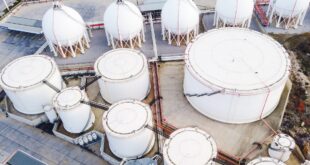Oil prices recorded a limited decline on Monday as investors profited from the highest oil prices seen since November and on expectations that Saudi Arabia and Russia’s curbs would continue through October.
International benchmark Brent crude traded at $88.48 per barrel at 10.21 a.m. local time (0721 GMT), a 0.08% loss from the closing price on Friday of $88.55 per barrel.
The American benchmark West Texas Intermediate (WTI) traded at the same time at $85.45 per barrel, down 0.11% from the previous session close of $85.55 per barrel.
Brent trade on Friday saw prices reach the highest level since last November at $88.99 a barrel on concerns that Saudi Arabia and Russia will maintain production curbs throughout October.
Concerns were amplified after Russian Deputy Prime Minister Alexander Novak said on Thursday that OPEC+ countries agreed on fresh supply curbs.
“Yes, we agreed. But we will announce the basic parameters next week, publicly,” Novak was quoted as saying by Russian media outlets.
Earlier last month, Saudi Arabia stated that it would extend its existing 1 million barrels per day (bpd) of output cutbacks through September. The country originally reduced output in July and extended it through August.
Likewise, Russia announced it would continue to voluntarily reduce oil exports. It said it would reduce exports by 500,000 bpd in August and cut 300,000 bpd in September.
Data suggesting some symptoms of softening in the employment sector further bolstered bearish market sentiment.
The American economy added 187,000 jobs in August, higher than market estimates of 170,000, while the unemployment rate jumped to 3.8% from 3.5% in July, the US Labor Department announced earlier.
Federal Reserve Bank of Cleveland President Loretta Mester stated Friday that the labor market remains strong while stressing that future interest rate decisions will be based on incoming data.
Analysts believe that if new data releases echo slowing inflation, the Fed may halt the rate rise in September and October.
Waning concerns about China’s economy, the world’s top oil importer, also aided oil price increases.
The Caixin manufacturing industry Purchasing Managers Index (PMI) increased to 51.0 in August from 49.2 in July, above analysts’ expectations of 49.3, to reach the highest level since February. Readings above the 50-point index indicate growth.
On Thursday, China’s central bank and financial regulator issued notices to modify several borrowing requirements to help homeowners, including decreasing the existing mortgage rate for first-time buyers and the down payment ratio in select locations.
The economic recovery is projected to remain fragile, putting further pressure on authorities to provide additional assistance.

 Iran Energy News Oil, Gas, Petrochemical and Energy Field Specialized Channel
Iran Energy News Oil, Gas, Petrochemical and Energy Field Specialized Channel



